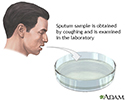Sputum stain for mycobacteria
Acid fast bacilli stain; AFB stain; Tuberculosis smear; TB smear
Sputum stain for mycobacteria is a test to check for a type of bacteria that cause tuberculosis and other infections.
How the Test is Performed
This test requires a sample of sputum.
-
To do this, you will be asked to
cough
deeply and spit the substance that comes up from the lungs (sputum) into a container.
Cough
Coughing is an important way to keep your throat and airways clear. But too much coughing may mean you have a disease or disorder. Some coughs are d...
 ImageRead Article Now Book Mark Article
ImageRead Article Now Book Mark Article - You may be asked to breathe in a mist of salty steam. This makes you cough more deeply and produce sputum.
-
If you still do not produce enough sputum, you might have a
bronchoscopy
.
Bronchoscopy
Bronchoscopy is a test to view the airways and diagnose lung disease. It may also be used during the treatment of some lung conditions.
 ImageRead Article Now Book Mark Article
ImageRead Article Now Book Mark Article
The test sample is examined under a microscope. Another test, called a culture, is done to confirm the results. A culture test takes a few days to get results. This sputum test can give your doctor a quick answer.
How to Prepare for the Test
It can help to drink a lot of fluids the night before the test. It makes the test more accurate if it is done first thing in the morning.
How the Test Will Feel
There is no discomfort, unless a bronchoscopy needs to be performed.
Why the Test is Performed
The test is performed when the doctor suspects tuberculosis or other Mycobacterium infection.
Tuberculosis
Pulmonary tuberculosis (TB) is a contagious bacterial infection that involves the lungs. It may spread to other organs.

Normal Results
Results are normal when no mycobacterial organisms are found.
What Abnormal Results Mean
Abnormal results show that the stain is positive for:
- Mycobacterium tuberculosis
- Mycobacterium avium-intracellular
- Other mycobacteria or acid-fast bacteria
Risks
There are no risks, unless bronchoscopy is performed.
Considerations
To increase the accuracy of this test, it is sometimes done three times, often three days in a row.
More sophisticated tests are sometimes used to stain sputum for mycobacteria. Check with your health care provider to see if these are available in the laboratory.
References
Murray PR. The clinician and the microbiology laboratory. In: Bennett JE, Dolin R, Blaser MJ, eds. Mandell, Douglass, and Bennett's Principles and Practice of Infectious Diseases . 6th ed. Philadelphia, PA: Elsevier Saunders; 2014:chap 16.
Septimus EJ. Pleural effusion and empyema. In: Bennett JE, Dolin R, Blaser MJ, eds. Mandell, Douglass, and Bennett's Principles and Practice of Infectious Diseases . 6th ed. Philadelphia, PA: Elsevier Saunders; 2014:chap 70.
-
Sputum test - illustration
A sputum sample is obtained by coughing deeply and expelling the material that comes from the lungs into a sterile cup. The sample is taken to a labarotory and placed in a medium under conditions that allow the organisms to grow. A positive culture may identify disease-producing organisms that may help diagnose bronchitis, tuberculosis, a lung abscess, or pneumonia.
Sputum test
illustration
-
Sputum test - illustration
A sputum sample is obtained by coughing deeply and expelling the material that comes from the lungs into a sterile cup. The sample is taken to a labarotory and placed in a medium under conditions that allow the organisms to grow. A positive culture may identify disease-producing organisms that may help diagnose bronchitis, tuberculosis, a lung abscess, or pneumonia.
Sputum test
illustration
Review Date: 11/24/2014
Reviewed By: Daniel Levy, MD, PhD, Infectious Diseases, Lutherville Personal Physicians, Lutherville, MD. Review provided by VeriMed Healthcare Network. Also reviewed by David Zieve, MD, MHA, Isla Ogilvie, PhD, and the A.D.A.M. Editorial team.

